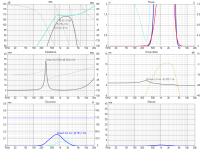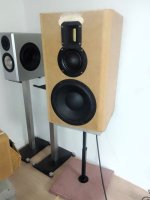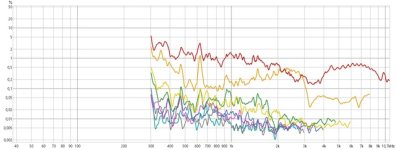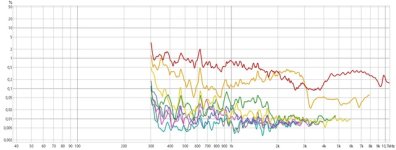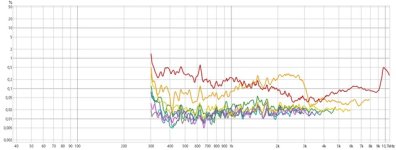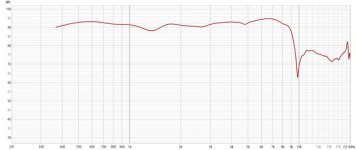@daanve Yes, you're correct. The 26NA is an aluminum alloy dome. I mistakenly said Ti and meant to say metal. Aluminum alloy usually sounds better than Ti apples to apples comparison. In reality, in its pistonic range, there's very little difference between the different metals. The breakup of each metal is different and can affect IMD as it can down modulate into the audible range.
Last edited:
D54 is excellent. I've used them in various designs and they take alot of power with minimal complaint. You can't cross them as low as the specs suggest but it really depends on the filter slopes and how loud you play them. I prefer the D52 to it because of its flat face plate, which is a little more neutral sounding. Not really that big of a difference between them.
A very important thing to check for with any and all older Dynaudio dome drivers - VC rubbing. Buyer beware when purchasing any used or NOS units, as nice and pretty as they may appear in that pristine box.
To check for VC rubbing or buzzing, simply perform a low level sine sweep in the range starting around the driver resonance frequency up to at least 1k. It will usually sound like a clipped sine wave or kazoo sort of sound. These mid domes (and tweeters) commonly suffer from misaligned or shifted VCs, causing the windings to contact the pole pieces. This is mainly due to the tight VC gaps they run, making the assembly process very critical. When these units are assembled, they're often completed before the adhesives and dome coatings had time to fully set which resulted in the dome / VC to settle in at a slightly skewed alignment in relation to the gap. Sometimes its just a matter of age or mechanical dome sag from the coating deteriorating over time, causing the dome to tilt slightly along with the VC.
This is such a common problem that virtually 1 out of 2 drivers will have a buzzing VC, so make sure you check the seller's refund policy before forking over a large amount of money for that nice shiny NOS driver in its original box. The buzzing can be harder to hear it with music at lower levels, so you'd assume or be told that its not a big deal, but running the driver this way will eventually cause the windings to fail or short, constantly rubbing on the upper pole plate. I've seen some of these older Dynaudio mid domes command crazy amounts of money, including the higher end Esotar and Esotec drivers, so be careful to do your homework before buying them. In all honesty, there are quite a few equal tiered or better mid domes out there which are less expensive ie. Bliesma, Morel, etc. Dynaudio can and usually will repair older units for you but its not cheap and you have to pay for shipping and customs fees in and out of Denmark. I’ve on occasion repaired them myself, but its highly tedious and is only an option if the VC is still in good shape despite buzzing. You're out of luck if the windings have burned and/or opened up.
To check for VC rubbing or buzzing, simply perform a low level sine sweep in the range starting around the driver resonance frequency up to at least 1k. It will usually sound like a clipped sine wave or kazoo sort of sound. These mid domes (and tweeters) commonly suffer from misaligned or shifted VCs, causing the windings to contact the pole pieces. This is mainly due to the tight VC gaps they run, making the assembly process very critical. When these units are assembled, they're often completed before the adhesives and dome coatings had time to fully set which resulted in the dome / VC to settle in at a slightly skewed alignment in relation to the gap. Sometimes its just a matter of age or mechanical dome sag from the coating deteriorating over time, causing the dome to tilt slightly along with the VC.
This is such a common problem that virtually 1 out of 2 drivers will have a buzzing VC, so make sure you check the seller's refund policy before forking over a large amount of money for that nice shiny NOS driver in its original box. The buzzing can be harder to hear it with music at lower levels, so you'd assume or be told that its not a big deal, but running the driver this way will eventually cause the windings to fail or short, constantly rubbing on the upper pole plate. I've seen some of these older Dynaudio mid domes command crazy amounts of money, including the higher end Esotar and Esotec drivers, so be careful to do your homework before buying them. In all honesty, there are quite a few equal tiered or better mid domes out there which are less expensive ie. Bliesma, Morel, etc. Dynaudio can and usually will repair older units for you but its not cheap and you have to pay for shipping and customs fees in and out of Denmark. I’ve on occasion repaired them myself, but its highly tedious and is only an option if the VC is still in good shape despite buzzing. You're out of luck if the windings have burned and/or opened up.
Great thread.
I read it again and newer posts due to recently acquiring some old Dynaudio D52 drivers, non-ferrofluid version. Serendipitously, just as I reach this point the topic turns to the D54 and D52!
Although the D52 has been mentioned in passing several times I haven’t seen much specific detail on them, such as reasonable crossover points and driver matches. Does anyone have experience with these drivers that they’d like to share (beyond what can already be taken from the substantial information given in the thread)? I’m hoping for something like 700 Hz - 5 kHz, but a bit lower would be good.
My plan is to use them with other existing old drivers I have for three-way domestic speakers, usually at low volume so compromise on maximum output will be acceptable as long as risk of damage is reasonably low.
I read it again and newer posts due to recently acquiring some old Dynaudio D52 drivers, non-ferrofluid version. Serendipitously, just as I reach this point the topic turns to the D54 and D52!
Although the D52 has been mentioned in passing several times I haven’t seen much specific detail on them, such as reasonable crossover points and driver matches. Does anyone have experience with these drivers that they’d like to share (beyond what can already be taken from the substantial information given in the thread)? I’m hoping for something like 700 Hz - 5 kHz, but a bit lower would be good.
My plan is to use them with other existing old drivers I have for three-way domestic speakers, usually at low volume so compromise on maximum output will be acceptable as long as risk of damage is reasonably low.
@steakandcheese I've used the D52 many times. All of the D52s I've ever purchased were without ferrofluid. The AF is supposed to be an abbreviation for "aluminum faceplate", but some people think its for ferrofluid.
Anyways, a 700 hz xover is ok, better if the primary Fs is notched. I ran the D52 with and without a notch at various crossover points. The notch makes a huge difference at higher volume levels, especially if you want to run 1st order filters (which I really don't recommend) or down to 600 hz LR2 with notch (a must at that low HP).
At 700 hz + LR2 to about 4 or 5k is a good happy medium range for this mid. Its very accurate, defined and clean in that range and will expose bad source and amplification, so be warned. My preferred xover is 800-1k+ LR2 to roughly 4k LR2 to a decent 19mm to 25mm+ soft / metal dome or at 5k with a good planar/ribbon/AMT. I really like and prefer the Seas 22TAF-G with it. The Audax TW025A28 is a bit better (more expensive) together with the D52. The top end is lightning fast and clean with huge dynamic range. The Hivi RT1.3WE is a very good (cheaper) planar and blends excellent above 4k. The narrow vertical dispersion is useful to blend with the D52 as it gets narrow up at the upper cutoff.
Really any accurate and open sounding tweeter with the D52 will go together well. I always recommend aligning acoustic centers on mids and tweeters. It makes a significant difference and simplifies the crossover.
Anyways, a 700 hz xover is ok, better if the primary Fs is notched. I ran the D52 with and without a notch at various crossover points. The notch makes a huge difference at higher volume levels, especially if you want to run 1st order filters (which I really don't recommend) or down to 600 hz LR2 with notch (a must at that low HP).
At 700 hz + LR2 to about 4 or 5k is a good happy medium range for this mid. Its very accurate, defined and clean in that range and will expose bad source and amplification, so be warned. My preferred xover is 800-1k+ LR2 to roughly 4k LR2 to a decent 19mm to 25mm+ soft / metal dome or at 5k with a good planar/ribbon/AMT. I really like and prefer the Seas 22TAF-G with it. The Audax TW025A28 is a bit better (more expensive) together with the D52. The top end is lightning fast and clean with huge dynamic range. The Hivi RT1.3WE is a very good (cheaper) planar and blends excellent above 4k. The narrow vertical dispersion is useful to blend with the D52 as it gets narrow up at the upper cutoff.
Really any accurate and open sounding tweeter with the D52 will go together well. I always recommend aligning acoustic centers on mids and tweeters. It makes a significant difference and simplifies the crossover.
So an update on the D7608 research.
I've been testing the limits of the dome's output capabilities and power handling. Its done a bit on the crude side of testing methods, but nonetheless I've found its possible to get 103 dB with a 500 hz sine and still have tolerable HD levels along with remaining within the excursion limits. The trick here is using the appropriate back chamber. This has lately been the focus of my research.
This dome is extremely sensitive to back chamber volume and requires the correct chamber size to get the best from, as I've been saying throughout my testing and sharing of info. I've been finalizing a chamber design to have a CAD file (and STL file) designed for the D7608 with the help of a generous fellow member on here. This will permit the use of the original felt material already on the dome. Some very light stuffing with fiberglass, Rockwool or sheeps wool is all the dampening that is required.
The new findings have led me to the conclusion that its possible to use crossover points down to 650 hz 2nd order while still allowing for healthy output levels ie. peaks of 105 dB.
The power handling will be no issue either. I've tortured a pair of D7608s with over 30W of continuous input for close to an hour without any permanent parameter changes. Its actually a very stout driver with good dynamic capabilities and can tolerate a little abuse.
At limited SPLs, response down to 400 hz is possible with a 98 - 100 dB output limit. The dome resonance Fs with proper chamber is 350 hz after driver break in. Free air Fs ends up at about 200 hz without chamber. Driver break in is a must. The dome responds well to loosening up with a few hours of pink noise at around 85 dB. It just gets better as it further loosens up.
I'll post the appropriate info once I have more of it.
I've been testing the limits of the dome's output capabilities and power handling. Its done a bit on the crude side of testing methods, but nonetheless I've found its possible to get 103 dB with a 500 hz sine and still have tolerable HD levels along with remaining within the excursion limits. The trick here is using the appropriate back chamber. This has lately been the focus of my research.
This dome is extremely sensitive to back chamber volume and requires the correct chamber size to get the best from, as I've been saying throughout my testing and sharing of info. I've been finalizing a chamber design to have a CAD file (and STL file) designed for the D7608 with the help of a generous fellow member on here. This will permit the use of the original felt material already on the dome. Some very light stuffing with fiberglass, Rockwool or sheeps wool is all the dampening that is required.
The new findings have led me to the conclusion that its possible to use crossover points down to 650 hz 2nd order while still allowing for healthy output levels ie. peaks of 105 dB.
The power handling will be no issue either. I've tortured a pair of D7608s with over 30W of continuous input for close to an hour without any permanent parameter changes. Its actually a very stout driver with good dynamic capabilities and can tolerate a little abuse.
At limited SPLs, response down to 400 hz is possible with a 98 - 100 dB output limit. The dome resonance Fs with proper chamber is 350 hz after driver break in. Free air Fs ends up at about 200 hz without chamber. Driver break in is a must. The dome responds well to loosening up with a few hours of pink noise at around 85 dB. It just gets better as it further loosens up.
I'll post the appropriate info once I have more of it.
hi,
i've tried to search this thread for an answer but didn't find any direct response to my question.
what do you think about using S-S d7608 as open baffle midrange let's say from 800hZ with Lr4/LR8 XO up to 3-3.5kHz (crossed to t25 with waveguide)?
vituix/basta shows that xmax stays well within limit (0.2mm) and rated power is the limiting factor. not that i need full output -> i will listen to it from let's say ~1-1.5m.
maybe any other dome midrange with detached back chamber would be better option?
thx!
i've tried to search this thread for an answer but didn't find any direct response to my question.
what do you think about using S-S d7608 as open baffle midrange let's say from 800hZ with Lr4/LR8 XO up to 3-3.5kHz (crossed to t25 with waveguide)?
vituix/basta shows that xmax stays well within limit (0.2mm) and rated power is the limiting factor. not that i need full output -> i will listen to it from let's say ~1-1.5m.
maybe any other dome midrange with detached back chamber would be better option?
thx!
Attachments
R u suggesting it as an alternative to the D7608 for Mathew? Roughly 10X price difference. 😂
Try it! I don't think there are many -- any? -- alternatives.what do you think about using S-S d7608 as open baffle midrange let's say from 800hZ with Lr4/LR8 XO up to 3-3.5kHz (crossed to t25 with waveguide)?
ha! this is the answer i was hopping not to read 🙂Try it! I don't think there are many -- any? -- alternatives.
A magnetoplanar open back without baffle is the choice that I and many others have done - B&G Neo8/10 or clones. Exactly similar response at 0-90 and 90-180deg. Distortion below 400Hz is challengingha! this is the answer i was hopping not to read
https://www.parts-express.com/GRS-P...44bCIj2CeNlp4kFx-F-9dm7JzpfihqAKuPn7Mwy6AMPG4
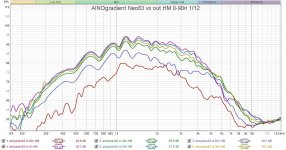
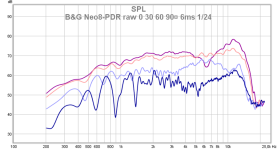
I see plenty of problems with this idea.what do you think about using S-S d7608 as open baffle midrange let's say from 800hZ with Lr4/LR8 XO up to 3-3.5kHz (crossed to t25 with waveguide)?
vituix/basta shows that xmax stays well within limit (0.2mm) and rated power is the limiting factor.
Why do you combine a tweeter with waveguide to a figure of 8 midrange?
Why crossed so high? Speaker distance will produce vertical lobing.
The back side frequency response will be quite different cause the path and volumes are very different. This will strongly distort your figure of 8 behaviour.
You would need to work with the driver to get the same response on both sides. And then the other questions still remain.
Yeah, I do too. My initial positive response was to the novelty of the idea, but no question the huge problem is the rear response would be very different -- much worse.I see plenty of problems with this idea.
Look at transsection and photos from the backside. Round 3cm deep cavity means strong standing wave mode and sharp diffractions in upper mid-treble transition freq. Compare how different response is above 1kHz, including directivity. https://hificompass.com/en/reviews/bliesma-m142t-6-7-textreme-dome-midrange
Hificompass measurements were done with the speaker installed on an IEC baffle (very wide), thickness around 20mm. So dipole effect (loss and axial nulling) on response is missing. https://hificompass.com/en/speakers/measurements
Actually it is very difficult to create real dipole pattern above 3kHz with any kind of combination of mid and tweeter - except with planars in minimal baffle..
Hificompass measurements were done with the speaker installed on an IEC baffle (very wide), thickness around 20mm. So dipole effect (loss and axial nulling) on response is missing. https://hificompass.com/en/speakers/measurements
Actually it is very difficult to create real dipole pattern above 3kHz with any kind of combination of mid and tweeter - except with planars in minimal baffle..
Last edited:
hello,
I came across this forum while looking for more dome midrange drivers.
I thought I would share my experiences with the HiVi DM-7500.
Using it in a three way combo with Fountek NeoCD3.5H and 10″ SB26SFCL38-8 (closed).
Currently still active separated at 400 Hz (12dB) and 4000 Hz (18dB)
The combination of ribbon and dome works brilliantly.
Even if the distortion of the Hivi seems somewhat increased.
If you opt for the HiVi, it makes sense to invest more in the bass than I did. The bass is deep and linear but you get a lot of distortion for free at this low price. Here are a few measurements.
Unfortunately I can't find the original pictures right now but the size is still sufficient.

1V

2.8V

5V

The peak in distortion at 630 Hz is only present in this dome; the other dome does not have this.
It is a prototype, but reducing the distance between HF and MF was a good decision for vertical radiation.

I came across this forum while looking for more dome midrange drivers.
I thought I would share my experiences with the HiVi DM-7500.
Using it in a three way combo with Fountek NeoCD3.5H and 10″ SB26SFCL38-8 (closed).
Currently still active separated at 400 Hz (12dB) and 4000 Hz (18dB)
The combination of ribbon and dome works brilliantly.
Even if the distortion of the Hivi seems somewhat increased.
If you opt for the HiVi, it makes sense to invest more in the bass than I did. The bass is deep and linear but you get a lot of distortion for free at this low price. Here are a few measurements.
Unfortunately I can't find the original pictures right now but the size is still sufficient.
1V
2.8V
5V
The peak in distortion at 630 Hz is only present in this dome; the other dome does not have this.
It is a prototype, but reducing the distance between HF and MF was a good decision for vertical radiation.
Attachments
- Home
- Loudspeakers
- Multi-Way
- The dome midrange thread
